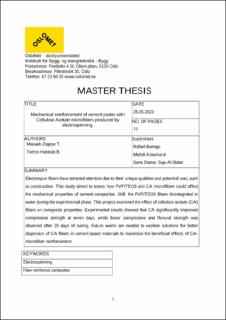| dc.description.abstract | Electrospun fibers have attracted much attention in various industries due to their distinctive qualities and possible uses, including construction. Electrospinning produces ultrafine fibers by exposing a polymer solution or melting to a high-voltage electric field. These fibers' nanoscale to micrometer sizes provides remarkable mechanical qualities and a high surface area-to-volume ratio. Electrospun fibers offer several benefits and modern advancements in the building construction industry, including increased strength and durability, improved energy efficiency, and environmental sustainability. The usage of electrospun fibers in the construction sector is still constrained, and areas still require improvement. Examples include pertinent parameters, scaling-up challenges, standardization, and regulations. As a result, the master has directed their efforts toward assessing a friendly method for the electrospinning process and innovative cement composites by reinforcing them with microfibers produced by their hand in the OsloMet Chemistry Lab to enhance flexural and compressive strength.
Initially, two different fibers, mainly cellulose acetate (CA) and polyvinylpyrrolidone/tetraethyl orthosilicate (PVP/TEOS), were considered for this study. These fibers were produced through a process called electrospinning, which involves the use of electrical forces to create delicate and continuous fibers. The objective was to assess how different types of fibers could affect the mechanical properties of composites made of cement. However, the PVP/TEOS fibers disintegrated in water during the experimental phase, making them unsuitable for further investigation. Therefore, only cellulose acetate (CA) fibers were considered for this project.
Three different mixes were prepared to examine the effect of CA on the final composite’s properties, each containing varying amounts of CA fibers: 0.1%, 0.5%, and 1%. Experimental results showed that CA significantly improved compressive strength at an early age. For instance, adding 1% CA fibers increased the 7d compressive strength by 13,8%, whereas adding 0.1% and 0,5% CA fibers improved compressive strength by 9.4% and 2,9%, respectively. This could be attributed to the increased interfacial interaction between CA fibers with the cement paste matrix. In contrast, lower compressive strength was observed after 28 days of curing. Similar results were noticed for flexural strength after 7 and 28 days. This was mainly attributed to the agglomeration of CA fibers within the cement paste. These agglomerated CA fibers give rise to regions of weak spots in the form of pores. On the other hand, it could generate additional macropores and thus weaken the cement matrix. Future works are needed to explore solutions for better dispersion of CA fibers in cement-based materials to maximize the beneficial effects of CA-microfiber reinforcement.
In summary, this work highlights the potential use of electrospun fibrous additives in composites based on cement. The results open new avenues for investigation and development in this unexplored field, enabling the development of innovative, high-performance building materials that can satisfy the strict demands of modern construction. | en_US |
